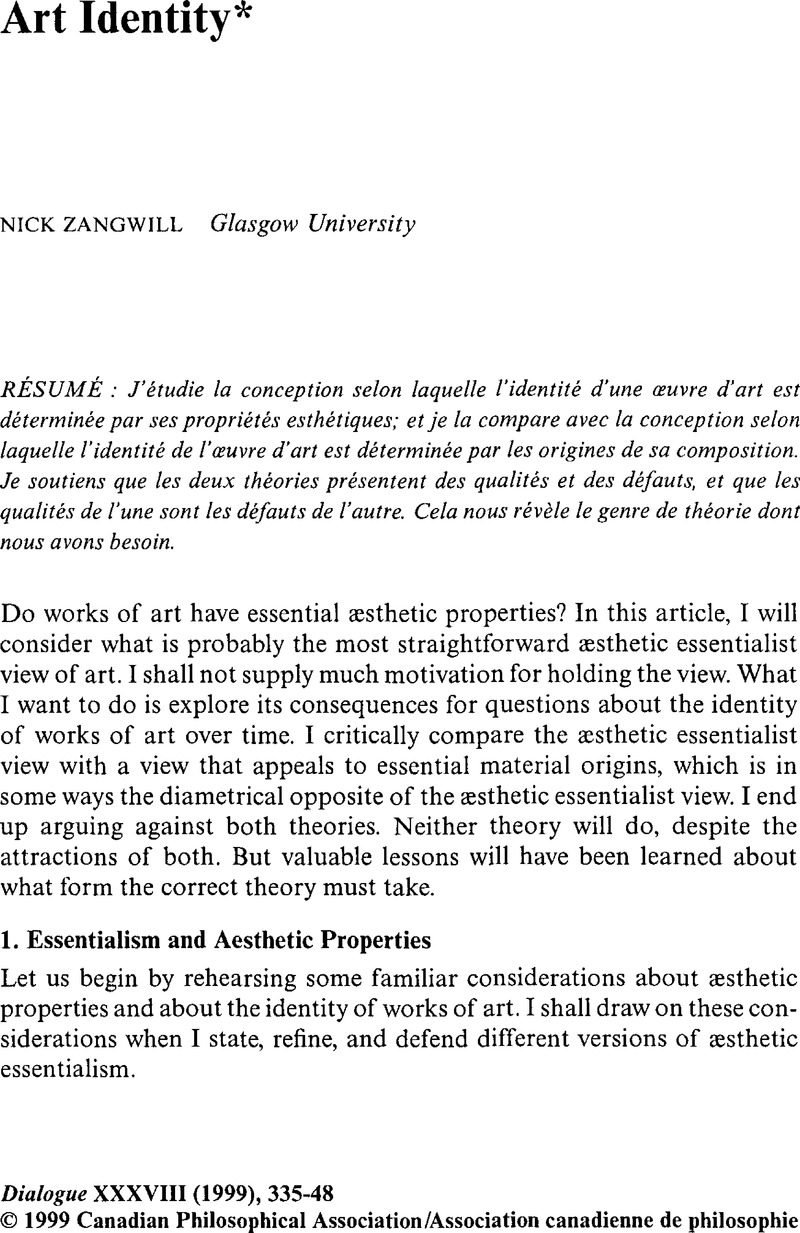No CrossRef data available.
Article contents
Art Identity*
Published online by Cambridge University Press: 13 April 2010
Abstract

- Type
- Articles
- Information
- Dialogue: Canadian Philosophical Review / Revue canadienne de philosophie , Volume 38 , Issue 2 , Spring 1999 , pp. 335 - 348
- Copyright
- Copyright © Canadian Philosophical Association 1999
References
Notes
1 See Zangwill, Nick, “The Concept of the Aesthetic,” European Journal of Philosophy, 6 (1998): 78–93CrossRefGoogle Scholar, and Zangwill, Nick, “The Beautiful, the Dainty and the Dumpy,” British Journal of Aesthetics, 35, 4 (1995): 317–29.CrossRefGoogle Scholar
2 See Kim, Jaegwon, “Concepts of Supervenience,” in Supervenience and Mind (Cambridge: Cambridge University Press, 1993)CrossRefGoogle Scholar. See also Sibley, Frank, “Aesthetic/Nonæsthetic,” Philosophical Review (1965).Google Scholar
3 Goldman, Alan argues against æsthetic supervenience in his Aesthetic Value (Bolder, CO: Westview, 1995), pp. 39–44Google Scholar. But his argument there takes as a premise a particular dispositional view of æsthetic value. He writes: “even fully developed and informed tastes can differ between ideal critics. Supervenience therefore fails” (p. 42). But the dialectic can equally cut the other way. Given the common-sense nature of æsthetic supervenience, there must be something wrong with Goldman's theory of æsthetic value. It should also be noted that not all “response-dependence” theories of æsthetic value are like Goldman's. For example, some response-dependence theories do not allow that ideal critics can disagree. And some response-dependence theories specify that things have dispositions to affect people in virtue of their intrinsic properties, in which case æsthetic supervenience can be respected.
4 Walton, Kendall, “Categories of Art,”Philosophical Review, 79 (1970): 334–67.CrossRefGoogle Scholar
5 See, for example, Danto, Arthur, The Transfiguration of the Commonplace (Cambridge, MA: Harvard University Press, 1981)Google Scholar, or Dickie, George, A esthetics (New York: Bobbs-Merrill, 1971).Google Scholar
6 Were we interested in genres rather than in particular works of art, we might consider the intuition that there just cannot be delicate heavy metal music.
7 This is not the claim that two objects or events cannot be instances or performances of the same work of art if they have quite different æsthetic properties. See, further, section 4 (g) below.
8 Note that some works of art involve change (for instance, plays and music) such that the work of art's æsthetic properties at one time are different from the same work of art's æsthetic properties at another. The cross-time essentialist claim only applies to a work of art considered as a whole.
9 See, further, Zangwill, Nick, “Hume, Taste and Teleology,” Philosophical Papers, 23, 1 (1994): 1–18.CrossRefGoogle Scholar
10 I do not think that there is a plausible dispositional account according to which there are, after all, dispositional similarities between apparently dissimilar graceful things.
11 Contrast Currie, Gregory, “Supervenience, Essentialism and Aesthetic Properties,” Philosophical Studies, 58 (1990): 243–57CrossRefGoogle Scholar. Currie denies that works of art have essential æsthetic properties on the grounds that æsthetic properties are determined contextually.
12 I criticize the institution-origin theory in “Doughnuts and Dickie,” Ratio, New Series 7, 1 (1994): 63–79CrossRefGoogle Scholar, and I explore and defend a creative-origin theory in “The Creative Theory of Art,” American Philosophical Quarterly, 32 (1995): 307–23.Google Scholar
13 For an example of such a view, see Levinson, Jerrold, “Zemach on Paintings,” British Journal of Aesthetics, 27, 3 (1987): 278–83.CrossRefGoogle Scholar
14 See Shoemaker, Sydney, Personal Identity, edited by Shoemaker, Sydney and Swinburne, Richard (Oxford: Blackwell, 1984).Google Scholar
15 To look beyond this article, the intuition behind CE was right: we need to combine the æsthetic approach with the origin approach. In my view, what we need to do is to factor the æsthetic properties into the origins of the work. This can be done either by saying that a work must have its origin in a thing with certain æsthetic properties, or by saying that æsthetic properties figure in the intentional or creative origins of the work. The latter approach is what I think we need. We then arrive at an origin-essentialist view, but not one which appeals to material origins. The resulting theory of art would be a kind of functional theory. See further my “Aesthetic Functionalism,” in Aesthetic Concepts: Essays After Sibley, edited by Brady, Emily and Levinson, Jerrold (Oxford: Oxford University Press, forthcoming).Google Scholar




